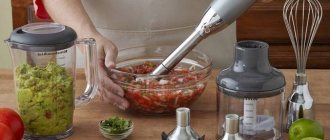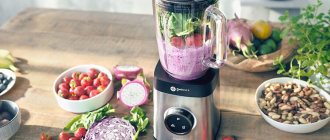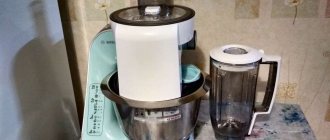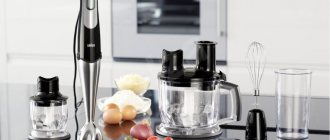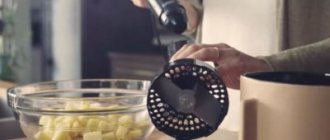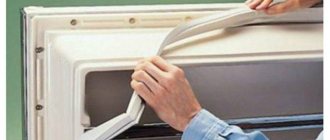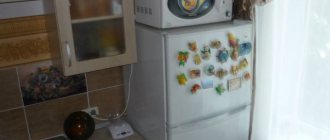Every person knows about such kitchen assistants as a blender and mixer. The names of these devices come from the English words mix and blend, which translated means “to mix.” This misleads many housewives into believing that the devices have the same purpose. Why then, when whipping in a stationary blender, does not you get such a fluffy foam as when using a mixer? What explains this? Is it possible to beat egg whites with a blender or is only a mixer suitable for this? You can get answers to these and other questions from our article.
General recommendations
General recommendations will help you correctly carry out the procedure for whipping the protein mass. So, you should follow these tips:
- Kitchen utensils must be clean and dry. This will allow you to correctly and quickly beat the whites to a thick foam.
- Fresh eggs are ideal for beating. Those products that have been in the refrigerator are more difficult to whip.
- Cooled whites separate better and easier from the yolk. But before whipping, you need to let the product (already separated) stand on the table so that it comes to room temperature.
- When using a mixer or blender, do not immediately turn on high speed. Start with the minimum, and gradually increase it as you beat.
- About halfway through whipping the protein mass, you need to add a little lemon juice, vinegar or citric acid, which will help increase the stability and strength of the foam, and also make sure that it does not settle. It will not be possible to re-whip the settled and separated foam. Everything will have to be redone.
- To obtain a more fluffy and stable foam, the whites are whipped with salt, unless the recipe requires the use of sugar. And one pinch is enough. Don't worry, you won't notice it in your taste.
Now you know how to beat the whites correctly so that they meet the requirements of the recipe. The whipping process itself is extremely simple. Of course, it is most convenient to use a blender or mixer, since these devices have special attachments for whipping, but you can do everything with a hand whisk, although this is more difficult. Follow useful recommendations to make the procedure seem easy.
How to beat egg whites with a mixer
Beating egg whites with a mixer is as easy as shelling pears. To do this, you must adhere to the following sequence of actions:
- Separate the whites of well-chilled eggs from the yolks and place them in a clean and dry bowl.
- Start beating the egg whites at low mixer speed for 2 minutes.
- Increase mixer speed to medium and beat egg whites for another 2 minutes.
- Continue beating the egg whites at the highest speed until they form fluffy foam with gently falling peaks.
- If the whites are whipped for further preparation of meringue or meringue, at this stage it is necessary to add sugar to the soft and fluffy mass, and at the very end of the process, pour in a few drops of lemon juice.
How to beat egg whites with a mixer is now clear. But the question remains as to whether it is possible to beat egg whites with a blender. We will try to answer this question below.
How to beat egg whites with a stand mixer
The main working element of this device is stainless steel knives that rotate at high speed. They ensure high-quality mixing of products, including those with a fairly dense consistency. The stand blender is ideal for making milkshakes, smoothies and pureed soups. For these dishes and cocktails, it will be enough to buy an inexpensive low-power device. A more powerful blender will be able to grind meat into minced meat, chop herbs and nuts. But is it possible to beat egg whites in a blender without a whisk?
A stationary blender is absolutely not suitable for preparing fluffy foam from proteins. Unfortunately, even the sharpest blades will not be able to mix the egg mass well. That is why, to obtain a lush foam, you will need to purchase a mixer or, in extreme cases, a hand whisk.
What is the difference between a mixer and a blender?
A kitchen mixer is designed to beat soft ingredients into a homogeneous mass. Structurally, it consists of the following parts:
- housings with control elements;
- spacious bowl for ingredients;
- interchangeable attachments - wide whisks and hooks for kneading dough.
When using a mixer, the products are loaded into the bowl, and then the unit is put into operation. The nozzles move around their own axis, and in some models also around the circumference of the container along an orbital trajectory. Thanks to this, the highest quality whipping of sauces, creams and proteins is achieved without dense lumps.
The mixer allows you to prepare a large amount of cream in a short time
The design of a stationary blender looks a little different. The device consists of:
- the base on which the levers and buttons for turning on and configuring the unit are located;
- a tall glass for loading products;
- rotating steel knives at the bottom of the container, responsible for grinding the ingredients.
During operation, the products are also placed in the bowl, the device is closed, the required power is selected and the unit is put into operation. The blades cut ingredients into small pieces or puree them at high speed, depending on the setting and cycle time.
The main difference between a blender and a mixer lies in its purpose. The first unit works with products of any hardness and can crush vegetables, nuts and even pieces of ice. The second interacts only with soft and viscous ingredients and does not cut them, but stirs them until they become a thick, homogeneous mass.
What is the difference between an immersion blender and a mixer?
Kitchen blenders are not only stationary, but also submersible. The latter consist of a grinding glass and a handle with a long metal “leg” and sharp knives in its lower part.
By default, when using a submersible unit, you need to load the products into the bowl, close the lid, and then install the main nozzle on top and put the device into operation. However, if desired, the device can grind the ingredients in any deep container - in a bowl, pan, plastic container.
Most often, submersible devices are equipped with an additional attachment - a metal or plastic whisk for whipping soft products. This gives them a certain resemblance to mixers. However, important differences remain between the instruments. In terms of power, an immersion blender is noticeably inferior to a stationary mixer and provides less quality whipping.
Some mixers can be removed from the base and used manually, like immersion blenders
How to beat egg whites if you don't have a mixer?
As it turned out, the whites can be beaten with a mixer or a hand whisk. The answer to the question of whether it is possible to beat egg whites with a blender can be answered in the affirmative, but only if the device is equipped with a “whisk” attachment. However, there is another “grandmother’s” way of beating egg whites - using a fork.
To get a fluffy foam, just put the whites of raw eggs in a clean and dry bowl and start rotating with a fork in a circular motion clockwise from bottom to top. After a minute, you can add a pinch of salt and continue whisking. After another couple of minutes, you can start adding sugar one spoon at a time. You can easily check the readiness of the meringue foam by simply turning the bowl over.
In a water bath
Beat egg whites in a water bath to prepare Swiss meringue. The latter is used to prepare an independent dessert, a base for sponge cakes, a layer for a cake, mousse, soufflé, and also as a decor for pancakes, muffins and various types of baked goods. The proportions for preparing meringue involve using 1 part protein, 1-2 parts sugar or powdered sugar.
The technology for preparing Swiss-type meringue involves the following steps:
- Pour sugar (or powdered sugar) into a heat-resistant container that can be placed in a water bath and add the whites. Mix gently, no need to beat yet.
- Pour water into a saucepan or saucepan for organizing a water bath and place on the stove. Wait for the liquid to boil.
- Place a container with egg whites and sugar on top of a pan of boiling water so that it does not touch the bottom. Beating at low speed, heat the whites to a temperature of 45-50 degrees. To measure, use a kitchen thermometer or use the old method - simply rub the protein-sugar mixture between your fingers: if the sugar melts, then the temperature is appropriate.
- After the sugar has completely dissolved, you can remove the container from the stove. Place it in a pan of cold water to stop the whitening process.
- Now continue beating the protein mass using a mixer or blender. The power can immediately be maximum. The process is quite quick, usually it does not take three to four minutes. You need to beat until the whites are completely cooled. Readiness can be judged by the formation of a moist, snow-white and shiny mass that is quite dense and strong.
Is it possible to beat egg whites with a blender?
The purpose of a mixer is to beat and mix products. The main working element of this device is steel whisks. That is why, if you don’t have a mixer, you can easily replace it with a regular hand whisk. The only difference will be in the speed of completing the task. Using an electric mixer, you can not only beat egg whites into foam and prepare a fluffy cream for decorating a cake, but also make the batter more elastic and homogeneous. With a hand mixer, all this will have to take at least 3 times longer.
But what to do if you don’t have a mixer at home or a hand whisk? Is it possible to whip egg whites into foam with a blender? This will not be difficult to do, but only if the blender is equipped with a whisk attachment. Whipping will take a little longer than when using a mixer, but the result will be the same thick and fluffy foam, which is perfect for making meringues.
Device differences
A mixer and a blender are devices that help housewives in preparing delicious and unusual dishes, but they confuse them when it comes to deciding which one to give preference to. To understand which kitchen gadget is more useful, let’s look at the functionality and operating principle of both devices.
Mixing liquid and bulk products and creating a homogeneous mass is what a mixer is used for. Mixers are:
- Manual. A device with replaceable nozzles. When using it, it must be held above a container with food. This machine is ideal for making cocktails, beating eggs and mixing liquid ingredients. But they cannot grind harder ingredients, such as boiled vegetables. These mixers can be powered by mains or batteries.
- Stationary. They are a bowl on a stand, equipped with a control panel. The advantage of this design is that the user's hands are free. The device comes with a 1.5-2 liter bowl, a whisk attachment and a dough hook attachment. The mixer stand is equipped so that its operation is not affected by vibration that occurs during operation.
Now that it is clear what a mixer is and what it is needed for, let's talk about the blender.
A blender is a multifunctional device. It does an excellent job of chopping, mixing and whipping various products. Just like the mixer, it comes in two types:
- Stationary. It consists of a jug, which is placed on a special stand equipped with sharp knives. The necessary products are placed in the jug and the device is activated using the buttons on the control panel. This blender model is more suitable for liquid ingredients, but sometimes it comes with ice picks.
- Submersible. It has an elongated shape, on one side there is a handle with control elements, and on the opposite side various attachments are attached. A bowl is not included with this device. They operate the device suspended, immersing it in a container with the necessary ingredients. A blender is used for beating, mixing and grinding products. With its help it is easy to prepare minced meat, puree soup, whip cream efficiently and make biscuit dough.
Attention! To understand which of the two appliances you should choose, consider your family's eating habits. If you often bake and prepare a variety of desserts, you cannot do without a mixer. If you need to grind food, for example, to prepare food for your baby, or you are a smoothie lover, then you should buy a blender.
Many housewives wonder how to use a blender as a mixer and whether it is advisable. The answer is simple: you need to put a whisk attachment in the blender. However, this option is suitable for whipping a small amount of ingredients, provided that the whole process takes no more than 5-7 minutes. When preparing a seven-egg sponge cake, egg white cream or meringue, the blender may overheat and the element holding the attachment will melt, as the operating time of the device will increase several times.
Advice! If possible, purchase both devices, as they have different functions and cannot fully replace each other.
Advantages and disadvantages of blenders
When using a blender, there are a number of advantages and disadvantages that affect the cooking process.
Advantages:
- chops both raw and cooked vegetables and fruits;
- high speed;
- after using the device, a homogeneous mixture is obtained;
- Multifunctional due to the various attachments included in the kit.
Flaws:
- the consistency of whipped products lacks airiness;
- a blender of almost any model needs frequent rest;
- makes loud noise when working;
- The submersible device covers a small area of the ingredients when grinding.
Advantages and disadvantages of mixers
The mixer gained popularity before the blender, so almost every kitchen has one. Many women cannot imagine how they would cope without such an assistant. This is due to its following advantages:
- the mixture after whipping is airy and fluffy;
- combines several functions: kneading dough, preparing creams and cocktails, beating eggs and cream;
- can work for a long time and not overheat;
- ease of care;
- speed of work.
The device also has disadvantages. They are due to the fact that:
- It is not recommended to use raw vegetables;
- there is no grinding function;
- will not work if the product is too thick or hard;
- the mixture will be homogeneous only when using liquid, semi-liquid or crushed products;
- a stand mixer takes up a lot of space;
- makes noise during operation.
Description
How to beat egg whites? To do this you need to use a blender or mixer. A hand whisk will also work, although the process will take longer and be more labor intensive. Egg whites are usually whipped either until soft foam or until stiff peaks form, depending on what the recipe calls for.
Many recipes cannot do without beaten egg whites. For example, the foam obtained in this way is used to prepare various desserts, sponge cakes, omelettes, cream for filling tubes, decorating pies, cakes, etc. You can simply bake chicken egg whites beaten with sugar or powdered sugar in the oven to create an appetizing meringue. The scope of use of persistent protein foam does not end there.
Let's figure out how to properly beat egg whites so that you get a strong and fluffy foam. No difficulties will arise if you read the recommendations and follow the step-by-step algorithm below.
Is it possible to beat egg whites with an immersion blender and how to do it correctly?
A blender is a useful tool in any kitchen. It can grind most products almost to puree. But people who are wondering whether it is possible to beat egg whites for meringue with a blender will be a little disappointed. The fact is that to obtain fluffy foam from egg whites, only the “whisk” attachment, which is usually included with the immersion blender, is suitable.
In general, whipping egg whites using a blender occurs in the following sequence:
- The white of a chicken egg is separated from the yolk and placed in a glass that comes with the blender.
- Start beating the egg whites at low speed in the blender.
- After 30 seconds, increase the mixer speed.
- Beat the whites until foamy.
In total, it will take 1-2 minutes to beat the whites.
Step by step instructions
Fresh multi-color farm eggs on the table.
So, all the ingredients are prepared, the dishes are washed and also prepared, you can get to work. Proteins are a very capricious product, so whipping should be done strictly according to proven instructions.
Important! Before breaking the eggs, rinse them well under running water. The surface of the shell may contain microbes and bacteria, as well as dangerous parasites.
The process itself consists of several basic steps:
- pre-cooled eggs are broken and the whites are separated from the yolks, placing them in a dry container;
- before whipping, add a pinch of salt and a little lemon juice to the container, they will facilitate the process;
- Beating begins at the minimum speed of the household appliance and gradually reaches the maximum possible, during which time the whites turn into a thick and fluffy foam.
Important! If the recipe specifies that the whites need to be beaten with sugar, it is better to use powdered sugar or a product with a fine fraction. You need to pour it into the container very slowly, in a thin stream, and do not stop rotating the whisk. The speed of the device should not be at its maximum at this moment.
